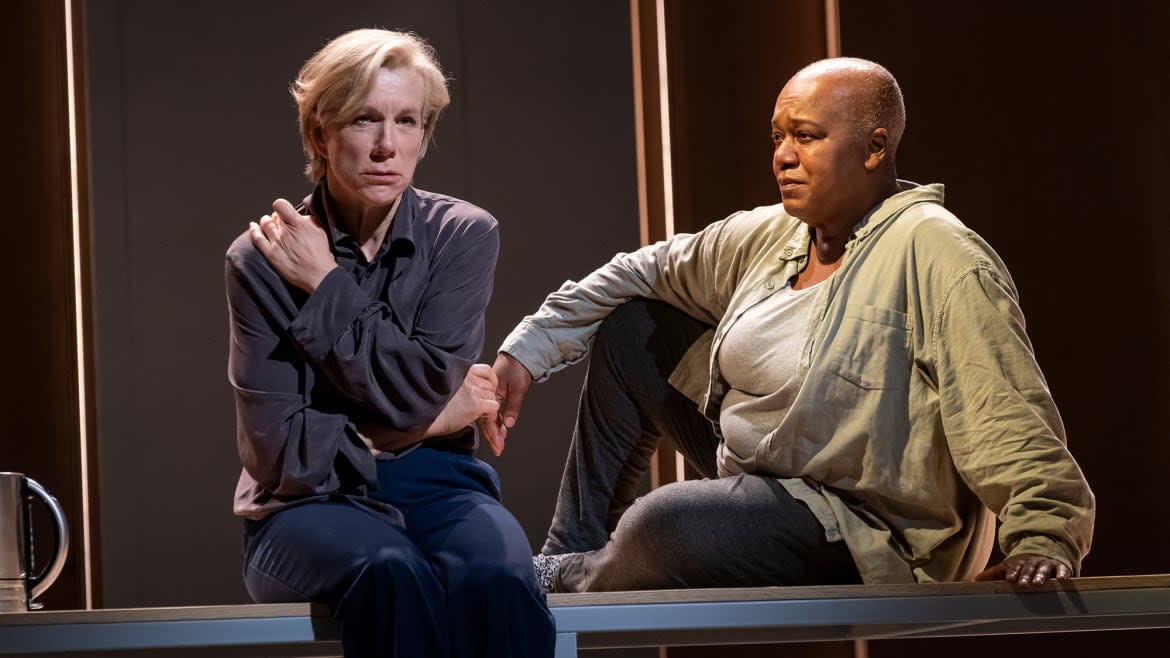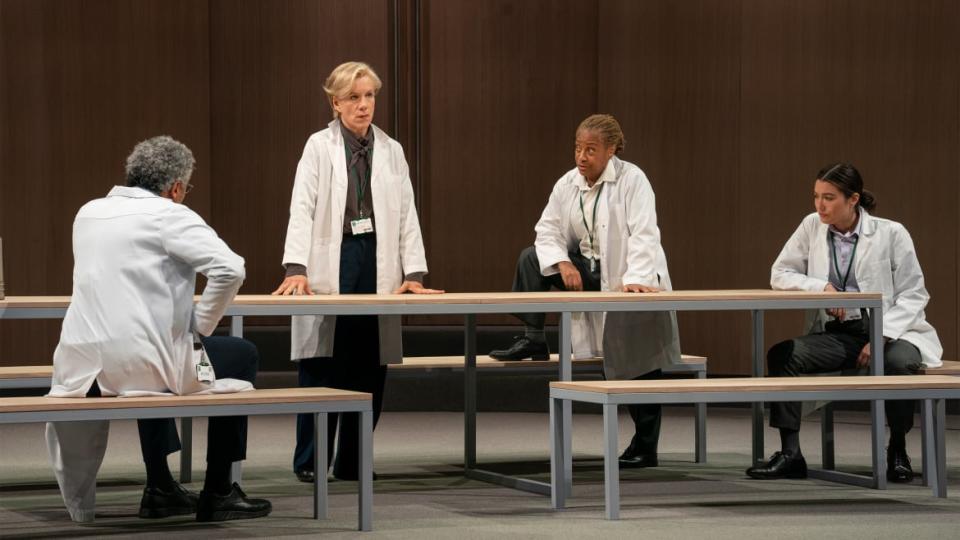Review: ‘The Doctor’ Will See You Now, Shouting Very Loudly

- Oops!Something went wrong.Please try again later.
- Oops!Something went wrong.Please try again later.
Caroline Aherne’s masterfully subversive comic creation Mrs. Merton used to cheerily encourage her audience to “have a heated debate.” That instruction—uttered twinkly as a parodic nod to the fiery, oxygen-hogging uselessness of all-sides debates on TV—kept occurring to this critic watching The Doctor (Park Avenue Armory, to Aug. 19), “freely adapted” and directed by Robert Icke after Arthur Schnitzler’s 1912 play Professor Bernhardi.
The play, performed on a stark stage at the Park Avenue Armory, with just a table and benches as décor, is one long, heated, borderline hysterical debate saved by the presence and power of Juliet Stevenson, who gives a commanding central performance as Dr. Ruth Wolff, whose career falls apart after she prevents a Black Catholic priest (John Mackay) from seeing a dying girl, the unseen Emily.
‘Kimberly Akimbo’ Is Triumphant at 76th Tony Awards
From this moment of discord springs forth a 2-hour, 45-minute debate about medical authority, hubris, identities, bias, racism, and faith versus science. To underscore its points, white actors and actors of color play racially and gender-fluid parts (an intriguing idea that ultimately doesn’t extend into anything deeper beyond a theatrical conceit that jolts the first time, then becomes familiar).
The play is a jagged sum of discordant parts. Stevenson is excellent as the fierce Wolff, who not only won’t give an inch, but scorns the obsessions with identity and feeling over fact and scientific necessity. Once her case goes public, Wolff’s bullheadedness only increases. She is determined not to offer any apology and give into the insanity of social media as its throngs circle to tear her apart. She prizes her authority as a doctor and a leader in her field over all else. She likes running things, ruling over things. She won’t countenance being questioned and challenged.
“Yes, I'm crystal clear. I’m a doctor,” Wolff says a self-propelling rallying cry. But it rings oddly empty. Despite Wolff’s rock-hard resistance to play any kind of ball—one of the most delicious lines said on stage this year has to be Stevenson’s deadpan-monotoned, “I’m trending”—the play ends up in a cul-de-sac of Points Being Made Very Loudly. Very, very loudly. For no reason at all, Stevenson and the cast, especially in the first half, simply shout at each other. This is from the get-go. There is no escalation to shouting and heightened emotion, just shouting and more shouting over what happened when Wolff prevented the pastor from seeing the girl.
Every point of view is represented: Wolff’s that she was just doing her job, and her supportive colleagues who scent a professional sacrifice, as well as antisemitism and sexism; and then those who think her actions show a high-handed arrogance, a racism she holds implicitly, and an antagonism toward God and faith. Wolff appreciates any support, but she also disavows any kind of groupthink or alliance based on characteristics such as her gender and Jewishness.
The debate in the first half, given both its excessive volume and repetitiveness, becomes exhausting. The play doesn’t give Wolff enough dramatic rope to hang herself with in terms of plot, and circles the same thematic ground over and over again. It doesn’t lead the characters anywhere new, and it doesn’t reveal anything new or interesting about the well-trodden subjects it obsessively fillets. Character is secondary to speechifying.

“The Doctor” at Park Avenue Armory.
You also have to buy that the premise leads to the scorched earth and hysteria that follows. But, at least to this critic, the setup is ridiculously meager. That may be the point—that all kinds of extremity can flow, especially in an age of social media, from a contested moment—but in The Doctor everything seems outsized and fury-filled from the beginning, as if the play can’t wait to start bellowing at itself.
In the second half, it features a TV show with panelists grilling Wolff—which is yet more heated debate, but not in service of the character in question. The play doesn’t seem to know, or want to tell us, if Wolff is an implicit, unconscious racist, or if she is or isn’t aware of her privilege. That may well make The Doctor an open text, but instead of feeling open, it feels like an airless, closed, anger-filled room.
The Doctor is an echo of The Thanksgiving Play, wringing its ostensibly liberal hands over what it can and can’t say around cultural sensitivities, ignoring a real world where conservative bigots are denying free speech, playing the victim as they bully marginalized communities, and relentlessly persecuting minorities like LGBTQ people, especially young trans people, in law. Just as in The Thanksgiving Play, the real enemy of our time—red-in-tooth-and-claw authoritarianism—is completely ignored in favor of a by now all-too-familiar whining about language and what people (and playwrights) feel they can and can’t say.
Thrown into the mix of The Doctor is a semi-parental relationship Wolff has with a trans teenager, then a euthanasia storyline around her former partner (hauntingly, beautifully played by Juliet Garricks). At the end, we see how the mess of the death of Emily, and the certainty and authority Wolff imposed upon it to her own cost, mirrors this death much closer to her home, which—in private—Wolff sought to have no authority over, and has since felt helpless about as a result.
We are led to a conclusion where science and faith meet face to face. That final scene, as carefully written as it is, also feels, like much of the play, a kind of all-sides balancing act.
It is thanks to Stevenson—the many emotions that cross her face, her imperious fury, her scornful curl of a lip, her chorus of nervous energies—that the production is so compelling. She is a magnetic, bold, and brilliant performer. But around her, the play feels a tired and claustrophobic rhetorical parlor game, echoing the bafflement we see on Stevenson’s face. What is she doing here, what has she done, she wonders over and over again. The play truly doesn’t seem to know, both about its lead character and itself.
A Simulacrum
It takes a certain skill to produce a pedestrian, humdrum show about magic, but A Simulacrum (Atlantic Stage 2, to July 2) manages it. It’s odd that it does, because it’s co-written by Lucas Hnath, who wrote the tremendous Dana H., and it uses a similar technique to Dana H. with a performer on stage acting in concert with a tape recording. In this case, the charming magician Steve Cuiffo stands on stage, responding to Hnath on tape as they rehearse and prepare the play we are seeing, written by both of them and directed by Hnath.
Dana H.’s uses of technology and a solitary performer—the astounding Deirdre O’Connell—yielded shocks, tension, and revelations aplenty. A Simulacrum features tricks (which are gently impressive), but it is also intended as a deconstruction of magic, and of Cuiffo’s personality and craft. This split focus becomes a drag, even with Cuiffo’s beguiling presence, Hnath’s taped goading, a teasing storyline around how Cuiffo’s wife feels about his magic, and the presence of a doll.
We are left with a magic show with some cool tricks that, quite naturally, resists showing too much of itself, because a true magician never reveals their method. But if a magician isn’t prepared to show himself in a play intended to somewhat reveal himself and his craft, then we are left with a teasing proposition and not much else.
Get the Daily Beast's biggest scoops and scandals delivered right to your inbox. Sign up now.
Stay informed and gain unlimited access to the Daily Beast's unmatched reporting. Subscribe now.

